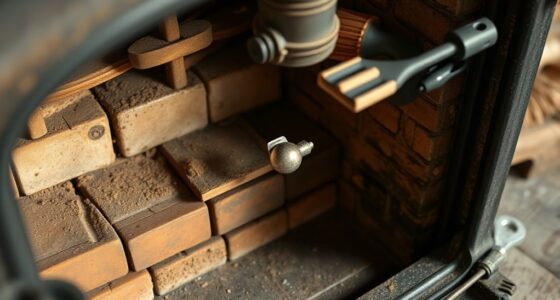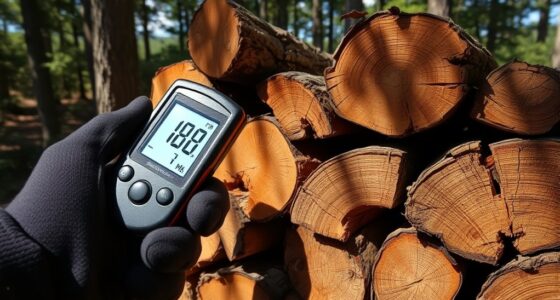To inspect for creosote stages 1-3, start by ensuring your fireplace or stove is completely cool and wear protective gear like gloves, goggles, and a dust mask. Use a flashlight or chimney camera to look up the flue, checking for flaky tan deposits for Stage 1, shiny black sticky patches for Stage 2, or thick, crusty black buildup for Stage 3. Following safety tips and proper techniques will help you detect these stages accurately—if you want to learn more, keep exploring the details.
Key Takeaways
- Wear protective gear and ensure the chimney is cool before inspecting.
- Use a flashlight to visually examine the chimney walls for creosote deposits.
- Look for flaky, light-brown deposits indicating Stage 1 creosote.
- Identify shiny, black, or sticky deposits that suggest Stage 2 creosote buildup.
- Detect thick, crusty, black deposits signifying Stage 3 creosote for professional cleaning.

Creosote buildup on your chimney or stove pipe can indicate different stages of deterioration that require attention. Recognizing these stages is key to maintaining a safe and efficient heating system. When inspecting for creosote, it’s essential to prioritize chimney cleaning and follow proper safety precautions to prevent accidents or fire hazards. Before starting, make sure your fireplace or stove is completely cool to avoid burns, and wear protective gear like gloves, goggles, and a dust mask to shield yourself from soot and debris. Remember, safety should always come first.
Regular chimney inspections and safety precautions are essential for preventing creosote fires.
As you inspect your chimney, pay close attention to the amount and appearance of creosote deposits. In Stage 1, you’ll find a flaky, light-brown or tan coating that’s easy to brush off. This stage is considered the least dangerous and typically indicates that your chimney might just need a routine cleaning. You can often remove this creosote with a chimney brush or professional cleaning tools. If you catch it early, cleaning is straightforward, and you reduce the risk of fire. Keep in mind, even with Stage 1 deposits, regular chimney cleaning helps prevent the buildup from advancing into more dangerous stages. Proper inspection techniques are essential for accurate assessment and safe maintenance.
Moving to Stage 2, creosote appears as a shiny, black, or sticky substance that adheres more firmly to the chimney walls. This stage indicates that the creosote has started to carbonize and is more difficult to remove. You may notice a tar-like feel when you run your finger over the deposits. At this point, it’s vital to perform a thorough chimney cleaning, either by doing it yourself with the right tools or hiring a professional. Failing to address Stage 2 creosote increases the risk of it igniting, which can cause dangerous chimney fires. Safety precautions become even more critical here — ensure you work in a well-ventilated area and avoid using open flames or sparks near the chimney.
In Stage 3, creosote becomes deeply ingrained, thick, and black with a hardened, crusty appearance. It’s often difficult to remove without professional tools or expertise. This stage is the most dangerous because the deposits are highly flammable and can lead to chimney fires if not cleaned thoroughly. When inspecting at this point, it’s wise to call in a professional chimney sweep, especially if you’re unsure about handling such stubborn deposits safely. Regular inspection and cleaning, combined with proper chimney maintenance, greatly reduce fire risk. Always follow safety precautions, such as closing the damper and ensuring proper ventilation, to prevent accidents during cleaning.
Frequently Asked Questions
How Often Should I Inspect My Chimney for Creosote Buildup?
You should inspect your chimney for creosote buildup at least once a year, especially before the heating season begins. Regular chimney maintenance helps prevent dangerous creosote fires and ensures safety. If you use your fireplace heavily or burn seasoned hardwood, consider inspecting more often, perhaps every few months. Always follow safety precautions during inspections, including wearing protective gear and ensuring the fire is completely out before examining the chimney.
Can Creosote Buildup Cause Chimney Fires?
Yes, creosote buildup can cause chimney fires, posing serious safety risks. It’s essential for you to prioritize chimney safety and regularly clean your chimney to prevent dangerous creosote accumulation. Fire prevention starts with proper inspections and timely removal of creosote, especially if you notice thick or glazed deposits. By staying vigilant and maintaining your chimney, you reduce the risk of fire and protect your home and loved ones.
What Tools Are Best for Inspecting Creosote Stages?
You can effectively inspect creosote stages with the right tools. Start with a chimney brush to loosen buildup, making it easier to see. Use an inspection mirror to get a clear view inside the flue, revealing stubborn creosote deposits. These tools help you assess whether you’re facing light, moderate, or heavy creosote, so you can take appropriate action and prevent potential chimney fires.
Is Professional Inspection Necessary for Creosote Stages 1-3?
You should consider professional chimney cleaning for creosote stages 1-3, especially if you’re unsure about the buildup or lack experience. A professional inspector can accurately identify the creosote stage and recommend proper creosote removal methods. Regular inspections ensure safe operation, reduce fire risks, and maintain your chimney’s efficiency. Don’t risk overlooking early-stage creosote; a professional inspection is a smart step toward keeping your chimney safe and clean.
How Do Weather Conditions Affect Creosote Formation?
Imagine your chimney like a sponge soaking up weather impact; temperature fluctuations cause creosote buildup to accelerate. Cold snaps followed by warm days create rapid condensation, leading to more creosote formation. High humidity also worsens the problem. You notice more creosote when weather changes suddenly, making it essential to regularly inspect your chimney, especially during seasons with unpredictable weather, to prevent dangerous buildup and guarantee safe operation.
Conclusion
By carefully inspecting for creosote stages 1-3, you can catch early signs of buildup, prevent dangerous chimney fires, and maintain a safe, efficient fireplace. Recognize the subtle changes, identify the thick, tar-like deposits, and stay vigilant with regular inspections. Keep your chimney clean, keep your home safe, and keep enjoying cozy fires. Staying proactive, staying informed, and staying safe are your best tools for managing creosote and ensuring peace of mind every time you light that fire.











